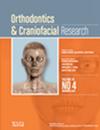The Mechanical Properties of Orthodontic Aligners of Clear Aligner After Intraoral Use in Different Time Periods
Abstract
Objective
Although the technique of orthodontic aligners has risen in popularity, their mechanical properties have not been thoroughly investigated. The aim of this study was to evaluate the mechanical properties of the orthodontic aligners Clear Aligner after intraoral use for 7, 10 and 14 days, and to compare them with as-received aligners (0 days). It was also sought to examine the properties of the unprocessed raw material (polyethylene glycol terephthalate) used to manufacture these aligners.
Materials/Methods
Thirty-two aligners by four patients were evaluated and studied at 0, 7, 10, 14 days of use. Each aligner was divided into three segments (two posterior and one anterior), which resulted in 96 samples. Also, 16 samples of unprocessed material were studied. For all samples, elastic modulus, ultimate tensile stress (UTS) and yield stress were calculated by conducting tensile testing. Additionally, material hardness was tested. The two-tailed Mann–Whitney test was performed, having set the level of significance at p = 0.05.
Results
Analysis of the measurements indicated a statistically significant decrease in elastic modulus between days 0 and 14 of use, of UTS between days 0 and 7, 7 and 10, and of yield stress between days 0 and 7. For hardness, in every period, posterior segments demonstrated significantly higher values than anterior segments. All properties of the unprocessed material were statistically significantly higher than the processed samples.
Conclusions
The unprocessed material presented significant differences in every property tested in comparison to the processed aligners. The processed material showed further deterioration over time during use. The present study provides evidence that thermoforming and ageing affect the mechanical properties of the aligners.


 求助内容:
求助内容: 应助结果提醒方式:
应助结果提醒方式:


